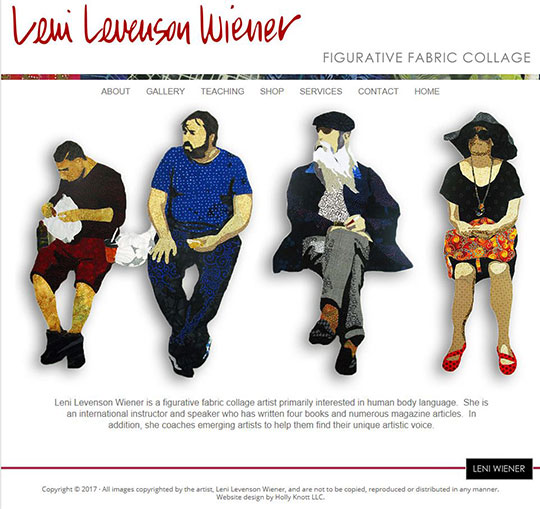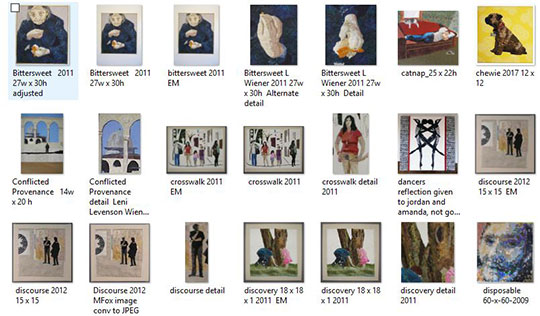Being Serious About Being a Serious Artist
Posted by Leni Levenson Wiener on Jul 7th 2017
Once you make the decision to take your art more seriously, you need to know your destination before you can set your path.
What do you most want to achieve as an artist? Do you need to make money from your art? Do you want to sell your work or do commissions? Sell at crafts and arts fairs? Do you want to write a book or teach workshops? The answers to these questions will color every decision you make going forward.
Setting goals
I recommend setting a long-term goal and an annual goal. The long-term goal is what you most want to ultimately achieve—in my case it was a solo museum exhibition (which came to fruition in 2015). The annual goal (which I only think about one year at a time, because it is always fluid) is a stepping stone. Your short-term goal might be to spend the year building a body of work, experimenting with new tools or techniques, creating a workshop, or proposing (or writing) a book. Every short-term goal should move you closer to your long-term goal in some way.
Sometimes your annual goal may seem like a failure, but it is never a waste of time if you realize you need to change course. Remember your art career is a journey, and the destination or the route might change as it develops. I spent one year focusing on gallery representation only to discover my work was not what galleries wanted. It didn’t alter my long-term goal, but I had to shift my priorities and my annual goals to get where I wanted by a different route.
Get your name out there
You could be the most fantastically talented artist in the world, but no one is going to find you if you don’t show your work. That could mean entering juried exhibitions, writing articles, writing a book, teaching high-profile workshops, or engaging in social media marketing. Build a reputation and let people know who you are and what you do.
Building a brand
As an artist, you are a brand, and everything you do must support that brand in a professional manner. The look of your support materials (card, letterhead, website) should be consistent with the look of your artwork and needs to be periodically re-evaluated and updated. You should also have a good head shot; like your artwork, it should be well-lit, in sharp focus, and without a lot of extraneous and irrelevant information. Luckily, none of this requires a large expenditure.

My letterhead
Artist statement, bio, and professional resume
Many artists do not understand the difference between an artist statement, a bio, and a professional resume. The artist statement is about your artwork, the bio is about you, and the resume lists your artistic accomplishments, such as exhibitions, publications, and awards.
Your artist statement is about your motivation, your methods, and what you want a viewer to take away from seeing your work. You are the artist so it should be in your voice, in your words, written in the first person. Write your artist statement so it sounds like you speaking—it shouldn’t be too technical nor should it contain flowery language or “art speak.” Too many artists think their artist statement should be art all by itself. You only get someone’s attention for a few seconds, don’t scare them away because they have to figure out both the artist statement and the art.
A bit of a misnomer, your bio is not your life history, it is about your life as an artist, and should include information relevant to your work. Don’t talk about your education, your job, your married life, your hobbies, your children, your grandchildren, or pets—even if they are the cutest things in the world—unless this information speaks directly to understanding your artwork. For example, if you are a marine biologist and your work is inspired by ocean life, that is relevant. My degrees are in art history, archaeology, museology, and restoration/conservation, but since none of that relates to my artwork in any way, it isn’t in my bio. I did work for several years as a commercial photographer and as all my artwork begins with one of my photographs, that is relevant and is in my bio.

Opening page of my website with short bio
Write two artist statements and two bios at the same time—a long version (less than one page) and a short version (one paragraph). The shorter version is a very quick overview (usually about fifty words—less than this paragraph), which does not give you much room to elaborate. Some exhibitions will ask for a longer version and some the shorter one. If they are already written and saved in your computer, your life will be easier.
Shipping
When you ship your work it should be with the same level of professionalism and care as everything else you do. Don’t use last night’s pizza box; reuse a box only if it looks clean and unrumpled. Use tissue and bubble wrap to prevent creases and place it all in a clear bag—not a garbage bag. Include in the box any notes or hanging instructions, neatly presented on your letterhead.
When shipping a piece to a buyer, it is nice to add a personal note and any required hanging hooks/nails, all tied with a pretty ribbon. You want everything about it to feel special.
Storing
If possible, store your work flat and cover it with a cotton cloth to prevent dust. Larger pieces can be rolled around a fabric bolt—both the cardboard bolt and then the rolled quilts covered with cotton pinned closed with stainless quilting pins. A label makes it easy to remember what is in the roll.
If you must fold your stored work, refold in a different configuration every few months to prevent creases and tears. Avoid plastic bags or boxes and instead use archival (or at least natural) materials whenever possible. Store your work away from dampness, extreme temperature changes, smoke, or pets.
Record keeping
I mentioned in a prior post that I keep a record of all works and relevant data on my computer. No fancy software, I simply have a folder with all the images of my work and an Excel spread sheet with titles, dates, sizes, prices, and any notes (like exhibitions or sales). In addition, I also save all the information about my workshops and talks; my artist statement and bio; my professional headshot (both 300 dpi for print and 72 dpi for Internet); a document that lists all pieces out for exhibition, including the name of that exhibition, the venue, contact info, and when it is due back; and a folder by year of all publications. All this is backed up on a portable hard drive in case anything happens to my computer.

Section of folder containing images and how they are labeled
You need to be serious about being a serious artist, know what you want out of your career, and make sure you stay on the path to get there, even when it twists and turns. Keeping everything you need organized and accessible means you can respond quickly without any stress, and that means you can spend more time making art.
Leni Levenson Wiener is a well-known and respected art quilter and the author of Pictorial Art Quilt Guidebook.







